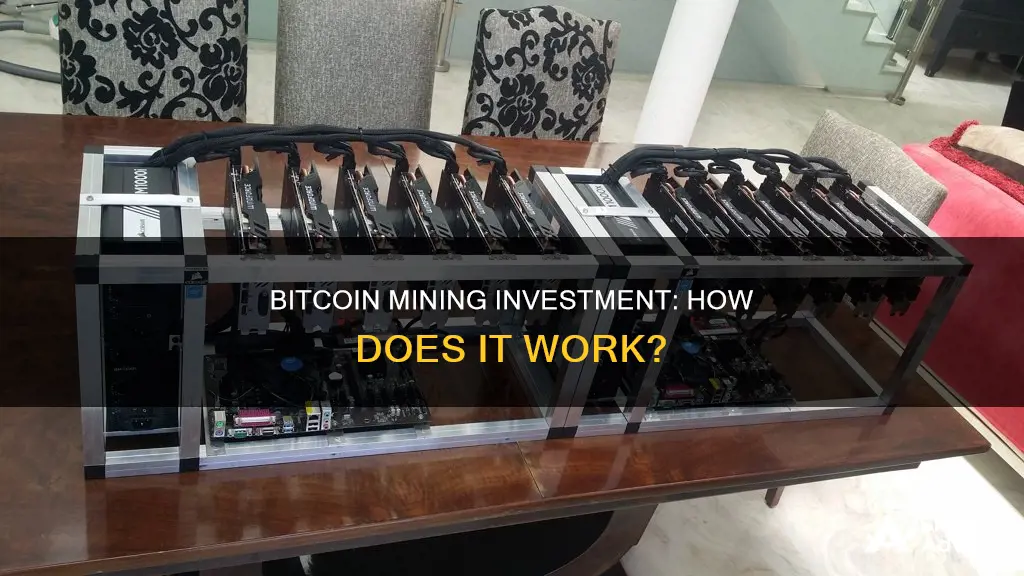
Bitcoin mining is the process of validating and confirming new transactions on the Bitcoin blockchain. It is also the way new bitcoins are introduced into the system. Bitcoin mining is a way to acquire valuable bitcoins without paying for them directly. However, the cost of the computer hardware, software and electricity required for mining is significant.
Bitcoin mining is still profitable for some individuals. However, this doesn't mean you can't make money mining bitcoin—it just won't be as lucrative as it used to be. Joining a pool and connecting a good home mining rig might net you a few hundred dollars monthly (if you're lucky) before you account for your expenses.
Bitcoin mining software lets you use computer hardware to help administer the blockchain technology that runs bitcoin. As a reward, you can earn newly created bitcoins.
What You'll Learn

Bitcoin mining software
- CGMiner: One of the oldest bitcoin mining software, CGMiner lets you mine other cryptocurrencies like Dogecoin and Litecoin. It is a highly flexible, open-source platform that helps you scale up your mining operations rapidly as it works with a variety of hardware options. It runs on Windows, Mac, or Linux and is compatible with ASIC hardware, FPGAs, and GPUs.
- Awesome Miner: This software lets you manage all your mining activity in one program, allowing you to manage multiple mining engines and control mining pools in the same place. It also offers a cloud-based web version that can be accessed via a browser on any internet-connected device.
- EasyMiner: If you're in a hurry to start mining bitcoin, EasyMiner is the right fit. It is an incredibly secure system that makes all your mining activity private while protecting your mined bitcoins from being stolen. It is mostly for less powerful CPU and GPU mining capabilities.
- Kryptex Miner: This Windows app pays users for their computer power. It offers a "lite mode" to allow internet use for other activities. Your mining work is paid in bitcoin or other payout options, ranging from Amazon eGift Cards to Visa/Mastercards denominated in fiat currencies.
- ECOS: ECOS is a cloud-based program that works online, so you don't need to buy cryptocurrency mining equipment. Instead, you pay upfront for a mining contract, and through that, you lease bitcoin mining equipment and electricity.
Other than the above, there are many other bitcoin mining software available in the market, such as Cudo Miner.
Bitcoin Investment: Scam or Legit?
You may want to see also

Bitcoin mining hardware
ASIC machines are the most powerful and efficient machines for Bitcoin mining, but they are also the most expensive. These machines can cost tens of thousands of dollars, but they offer the best chance of turning a profit through Bitcoin mining.
When choosing Bitcoin mining hardware, there are several factors to consider:
- Profitability: The most profitable mining machines are often the most expensive. It is important to calculate the potential return on investment and how long it will take to recoup the initial cost of the hardware.
- Hash rate: A higher hash rate means a more powerful machine, but it also typically means higher power consumption and increased electricity costs.
- Power consumption: The power consumption of the machine will impact electricity costs, which can be substantial for powerful machines.
- Noise levels: Crypto mining machines are typically loud, ranging from 50 to 75 decibels. This may be a consideration when deciding where to set up the hardware.
- Cooling: Mining machines generate a lot of heat, so adequate cooling is important to prevent overheating. Water cooling is more effective than fan cooling but may be more expensive.
Some of the most profitable and popular ASIC Bitcoin mining hardware include:
- Bitmain Antminer S21 Hyd 335T: One of the latest machines on the market, released in February 2024, with a hash rate of 335Th/s and hydrocooling. It is relatively inexpensive at $4,200+.
- Canaan Avalon Made A1366: A high-performance mining rig released in November 2022, with a hash rate of 130 terahashes per second and a power consumption of 3250 watts. It features six fans for cooling and has a user-friendly interface.
- MicroBT Whatsminer M50S: A lower hash rate of 126 terahashes per second but is far cheaper than other machines, starting from $2,999. It has a power consumption of 3276 watts and two fans for cooling.
- MicroBT Whatsminer M56S: A hash rate of 212 terahashes per second and water cooling make this one of the best Bitcoin miners on the market. However, the high hash rate comes at a cost, with a power consumption of 5550 watts.
- Bitmain Antminer S19 XP Hyd: A top-of-the-line rig with a hash rate of 255 terahashes per second. However, the high hash rate results in a power consumption of 5304 watts, which may deter investors due to the high running costs.
It is important to carefully consider the specifications and costs of Bitcoin mining hardware before investing, as well as the potential profitability and return on investment.
Bitcoin: Long-Term Hold or Short-Term Investment Gamble?
You may want to see also

Bitcoin mining pools
Bitcoin mining is a costly and energy-intensive process. As more miners join the network, the work required to mine a block increases, ensuring that blocks are produced every ten minutes on average. To compensate for the high costs of mining, miners are awarded new bitcoins each time they produce a block.
Mining pools allow miners to aggregate their resources and distribute the rewards they receive. This helps smaller miners smooth out their revenue at the cost of a fee paid to the pool coordinator.
The role of the pool coordinator is to ensure that participants in the pool are not overlapping in their efforts and are always generating different hashes to maximize the chances of their pool finding a block. Whenever any miner in the pool finds a block, they pay the block reward to the mining pool coordinator. After taking a small fee, the coordinator pays each member of the pool based on their hash rate contribution.
Benefits of Bitcoin Mining Pools
The existence of Bitcoin mining pools allows individuals and smaller entities to mine profitably and enjoy reliable revenue. This prevents Bitcoin mining from being solely controlled by massive corporations and preserves Bitcoin's decentralisation.
Drawbacks of Bitcoin Mining Pools
By taking part in a mining pool, individuals give up some of their autonomy in the mining process. They are typically bound by terms set by the pool itself, which may dictate how the mining process is approached. They are also required to divide up any potential rewards, meaning that the share of earnings is lower for an individual participating in a pool.
Examples of Bitcoin Mining Pools
- AntPool
- Foundry
- ViaBTC
- F2Pool
- Binance Pool
A Beginner's Guide to Investing Bitcoin in Malta
You may want to see also

Bitcoin mining costs
Electricity costs are incurred due to the power required to run mining systems continuously. Cooling costs are also included in this category, as mining systems produce significant heat.
Mining systems refer to the hardware used for mining Bitcoin. While desktop computers and gaming systems can be used, they are less efficient and competitive than specialised ASIC mining machines, which can cost thousands of dollars each.
Network infrastructure costs involve the need for a fast and reliable internet connection to communicate with the rest of the Bitcoin network. Latency, or the time it takes to communicate with the network, is a critical factor.
The total costs of these three categories should be less than the price of Bitcoin for a mining operation to be profitable.
In addition to these direct costs, there are other financial risks and considerations associated with Bitcoin mining. The volatile price of Bitcoin can impact revenue, and increased competition from other miners can make it harder to win blocks and receive rewards. Operational risks include potential issues with internet connectivity, overheating, and system hacks.
The availability and reliability of electricity are crucial, as power outages can disrupt mining operations. The cost of electricity is also a significant factor, with higher electricity prices impacting profitability. Regulatory and environmental concerns related to energy consumption and carbon footprint have also been raised, leading some companies to explore renewable energy sources and carbon offsets.
Overall, the profitability of Bitcoin mining depends on various factors, including electricity costs, network difficulty, and the price of Bitcoin.
A Guide to Investing in Bitcoin in Kenya
You may want to see also

Bitcoin mining profitability
The first factor to consider is the mining setup. Bitcoin mining requires specialized hardware, such as graphics processing units (GPUs) or application-specific integrated circuits (ASICs). These machines can be expensive, ranging from a few thousand dollars to tens of thousands of dollars. The more powerful the machine, the faster it can generate hashes, increasing the chances of receiving rewards.
Electricity costs are another significant expense in bitcoin mining. The process of mining consumes a large amount of electricity as miners compete to solve complex cryptographic problems. Additionally, the heat generated by the mining equipment requires cooling systems, further adding to the energy costs.
The price of bitcoin also plays a crucial role in determining the profitability of mining. The value of bitcoin has been highly volatile, and the rewards for mining are cut in half every four years. As a result, miners aim to receive as many bitcoins as possible before the supply of new coins diminishes over time.
To increase their chances of success, miners often join mining pools, which are groups of miners who combine their computational resources. By working together, miners can increase their hashing power and have a better chance of receiving rewards. However, the rewards are typically split based on the amount of work contributed by each participant.
Lastly, it's important to consider the risks associated with bitcoin mining. The financial risk is significant, as miners may invest in expensive equipment without any guarantee of returns. Additionally, the legal status of bitcoin mining varies across jurisdictions, and there are environmental concerns due to the high energy consumption and electronic waste generated by mining activities.
In conclusion, bitcoin mining profitability is influenced by a combination of factors, including initial investments, ongoing costs, the price of bitcoin, and the competitive nature of the mining process. While it offers the potential for profits, it also carries financial and environmental risks that miners should carefully consider before investing in this endeavour.
Smart Ways to Invest 50 Dollars in Bitcoin
You may want to see also
Frequently asked questions
Bitcoin mining is the process by which transactions are entered on the blockchain. It is also the way new bitcoins are launched into circulation. Miners use hardware and software to generate a cryptographic number that is equal to or less than a number set by the Bitcoin network's difficulty algorithm.
Miners compete to be the first to guess a string of letters and numbers called a hash, or to get the closest solution within a 10-minute window. The string has 64 characters, so miners use their computers to generate guesses. The more powerful your computer, the more guesses you can submit per second (this is called a 'hash rate'), and the better your odds of winning.
Bitcoin mining can be profitable, but it is a high-risk investment. The performance of cryptoassets can be highly volatile, with their value dropping as quickly as it can rise. There is also no guarantee that investments in cryptoassets can be easily sold.
To start mining Bitcoin, you need to select a mining pool and download a compatible mining program. Some pools have graphic interfaces that help you get set up, while others have instructions on their websites. Once you're set up, initiate the mining program.







